Inside: Here are some easy, creative ways to improve your rain gutter drainage and shield your home from water damage. These ideas can help keep your yard and foundation safe and dry.
If you want rainwater to flow away from your house, you’ll need solid drainage solutions.
This guide rounds up 27 simple, practical ways to manage rain gutter drainage and dodge headaches like flooding and erosion.
You’ll see options for different budgets and home styles. Pick what works for your space and your wallet.

1. Install gutter guards to keep debris out
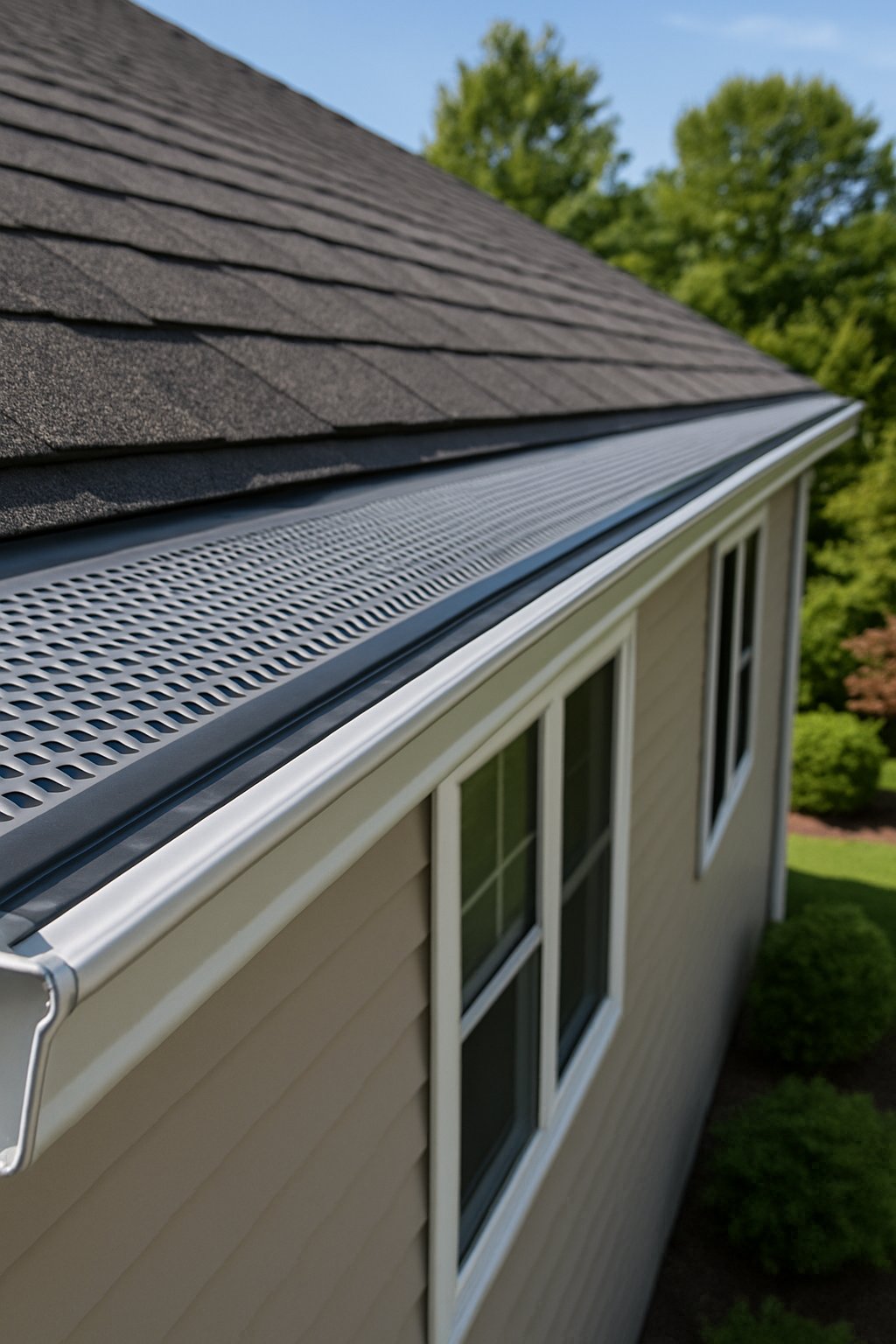
Try adding gutter guards to stop leaves and debris from clogging up your gutters. These guards sit on top and let water through while blocking bigger stuff.
They’re pretty easy to put in yourself and can save you time cleaning. Just make sure they fit snugly and cover both the gutter and downspout spots.
Expert Tip from MrPlanter: “Choose guards that are easy to remove for occasional cleaning. Proper fit around downspouts is key to avoiding backups.”
- [EASY TO INSTALL] This kit includes 48 FT. (Nominal) of Stainless Steel Micro-Mesh Gutter Guard and self-tapping screws....
- [QUALITY & PERFORMANCE] Engineered with Stainless Steel Micro-Mesh, offering unmatched strength and durability. Offers...
- Efficient Year-Round Protection: The gutter guard blocks leaves and debris while allowing water to flow freely, reducing...
- Durable Construction: SDSNTE gutter guards are made from durable powder-coated steel, ensuring long-lasting protection...
2. Attach downspout extensions to move water away
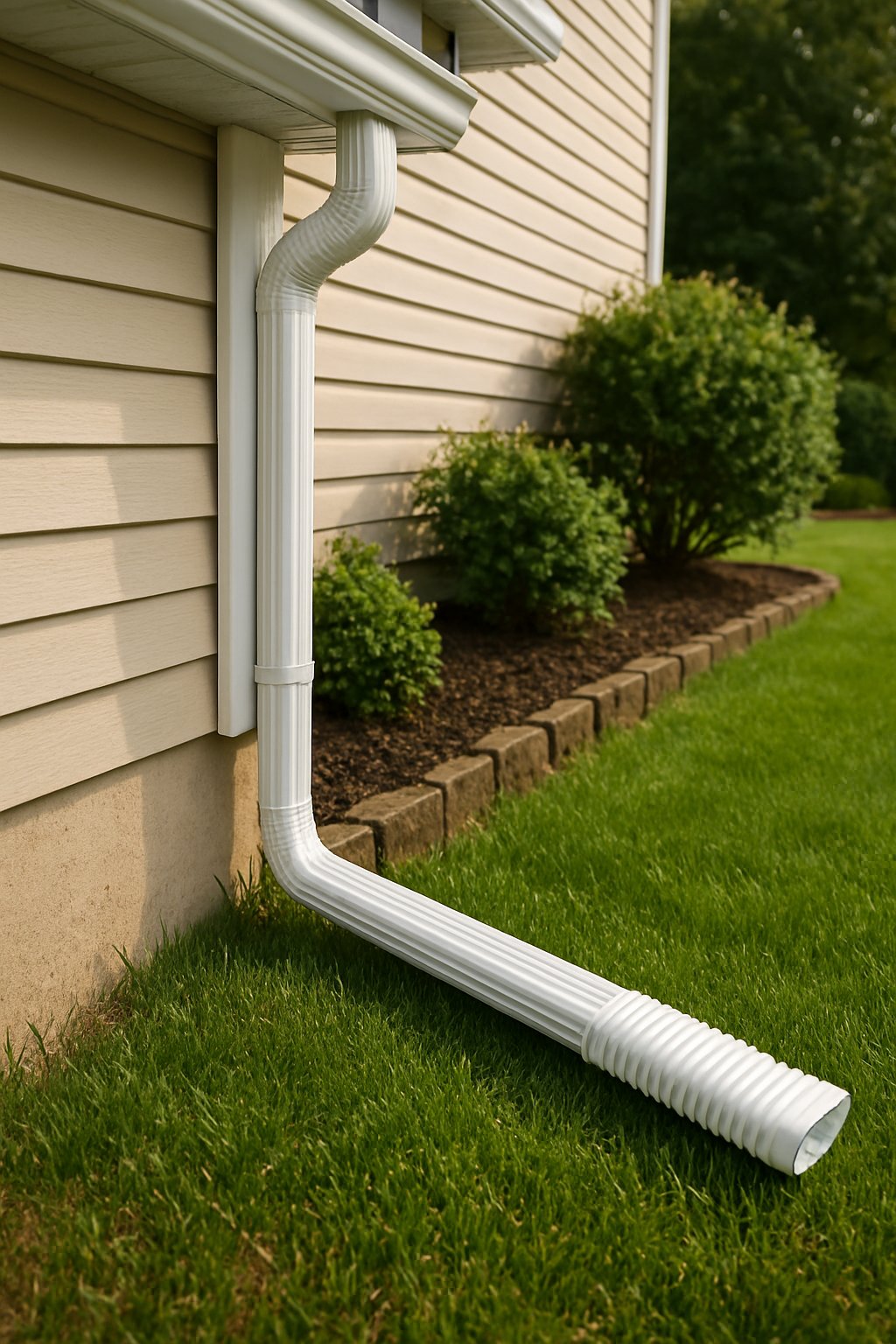
Attach downspout extensions to guide rainwater away from your foundation. These extensions help stop water from pooling by your house and lower the risk of damage.
Flexible or corrugated tubing works well—just make sure it fits your downspout. You can bury it or leave it on top, depending on your yard.
Expert Tip from MrPlanter: “Make sure the extension directs water at least 4-6 feet from your foundation. Check it regularly to avoid clogs or damage.”
3. Use corrugated drainage pipes underground
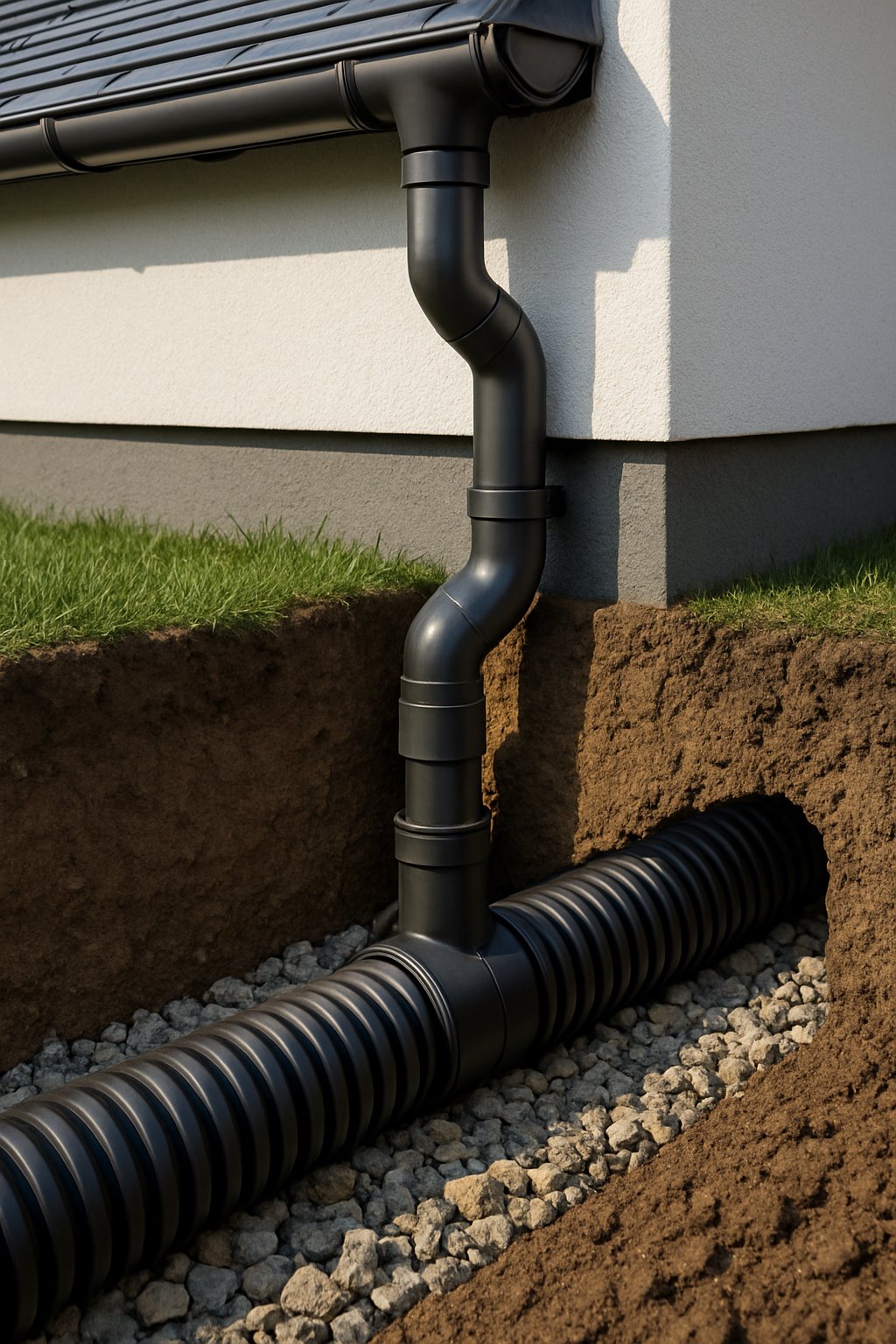
Bury corrugated drainage pipes to move water away from your gutters. These pipes bend easily, so you can work around trees or garden beds.
Run the pipe at least 15-20 feet from your house to keep water from pooling. Use an adapter to connect the downspout, and add a filter to block debris.
Expert Tip from MrPlanter: “Always slope the pipe slightly away from your house to ensure water flows smoothly. Use a cleanout plug to make future maintenance easier.”
- This product adds a great value
- Product is highly durable and very easy to use
4. Create a French drain to redirect water
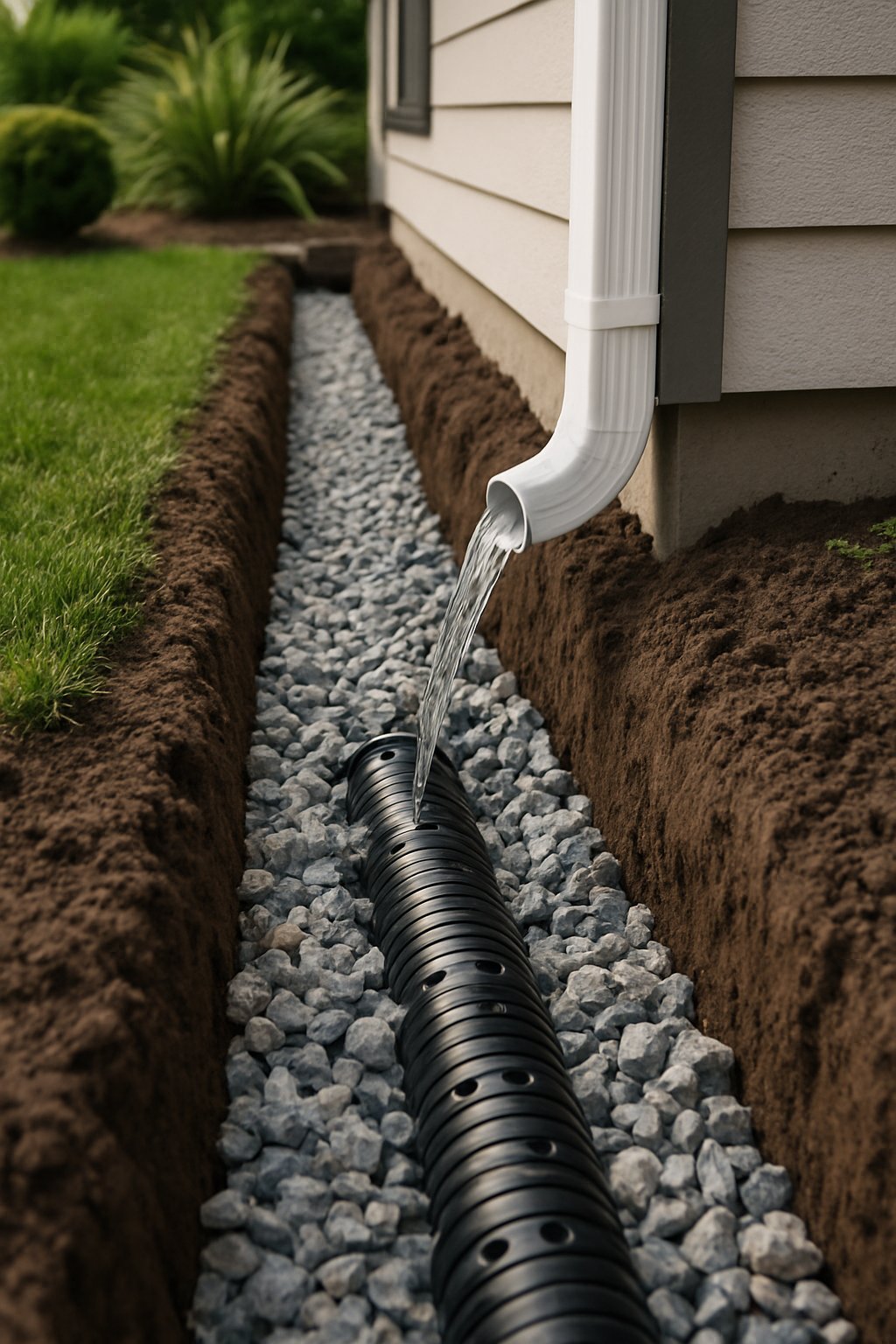
Dig a trench, fill it with gravel, and you’ve got a French drain. It’s a classic way to move water away from your gutters.
You can bury your downspouts into the drain to steer runoff away from your foundation. This works especially well if your yard slopes or gets soggy.
Expert Tip from MrPlanter: “Make sure the trench has a slight slope to keep water flowing. Use landscape fabric to keep soil from clogging the drain.”
- Low Profile Design. This catch basin can be installed without deep digging. You no need to connect to the downspout....
- Pipe Size: Inside Diameter: 2 inches; Outside Diameter: 2.4 inches. Extendable Flexible Pipe from 2.3ft to 8.2ft. The...
5. Install a dry well to collect runoff

A dry well collects rainwater from your gutters and holds it underground, letting it slowly soak into the soil. This stops puddles and helps prevent flooding near your house.
Build it with crushed stone, perforated pipes, and landscape fabric. Place it where your roof drains for best results.
Expert Tip from MrPlanter: “Make sure to size your dry well based on your roof area. This helps it handle heavy rain without overflowing.”
6. Use Schedule 40 PVC pipes
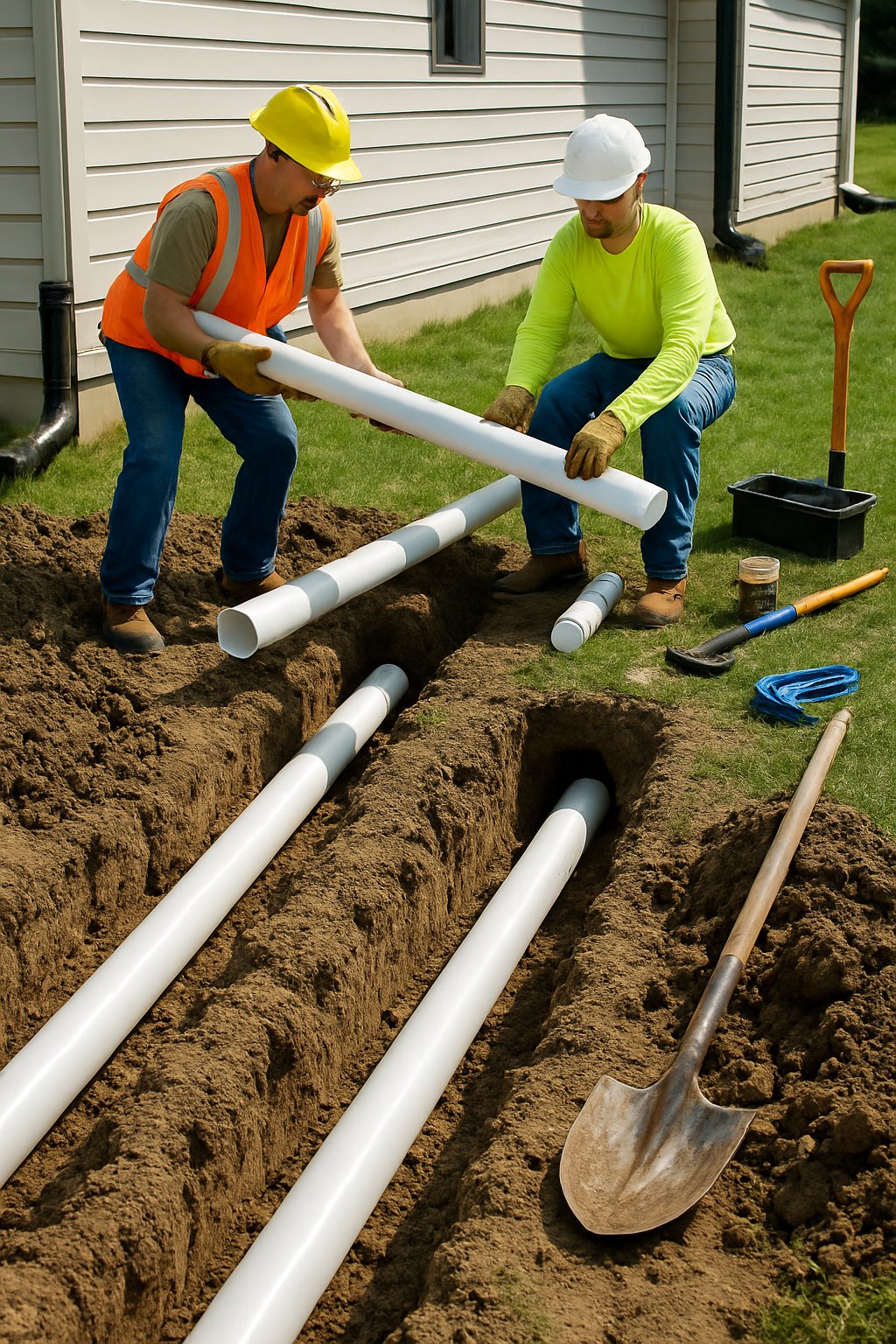
Bury Schedule 40 PVC pipes in trenches to carry water away from your gutters. Slope the trench a bit so water keeps moving.
Solid PVC pipe lasts a long time. Cover it with soil or gravel to protect it.
Expert Tip from MrPlanter: “Always check the slope before covering the pipe to avoid blockages. Use gravel around the pipe to help with drainage and pipe stability.”
- Size - Length of each: 17";The 1/2 inch Schedule 40 PVC pipe has an outer diameter of 0.84 inches and an inner diameter...
- Indoor & Outdoor Material - Made of high-quality Sch40 PVC material, with high plasticity, low temperature resistance,...
- Size - Length of each: 17";The 3/4 inch Schedule 40 PVC pipe has an outer diameter of 1.05 inches and an inner diameter...
- Indoor & Outdoor Material - Made of high-quality Sch40 PVC material, with high plasticity, low temperature resistance,...
7. Add splash blocks at downspouts
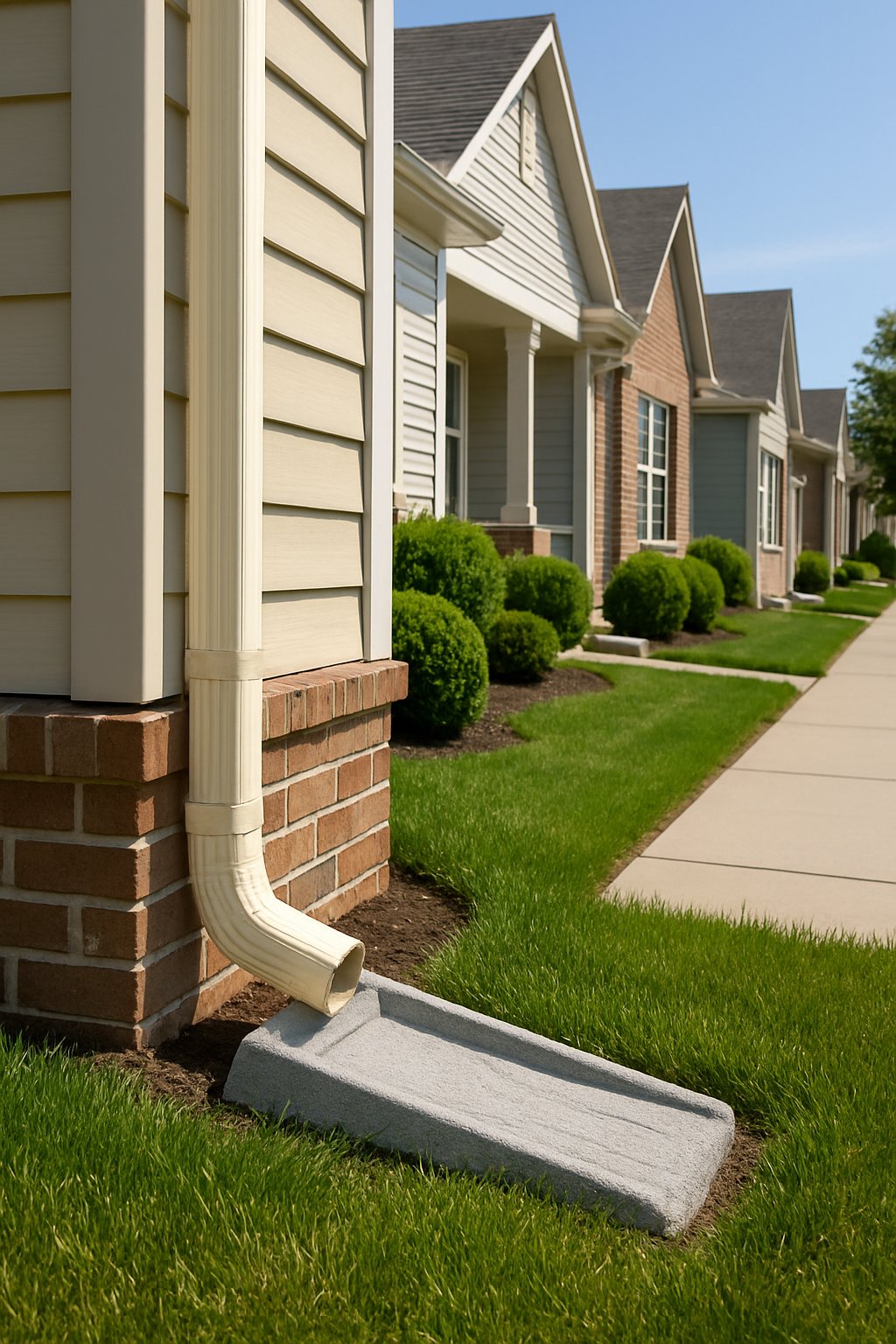
Place splash blocks right under your downspouts to guide water away from your foundation. They slow the water and help prevent soil erosion.
Pick sturdy materials that can handle heavy rain. Set the splash block on a flat spot for best results.
Expert Tip from MrPlanter: “Make sure your splash blocks are clear of debris to keep water flowing freely. Angle them so water drains safely away from your foundation.”
8. Route runoff into storm drains
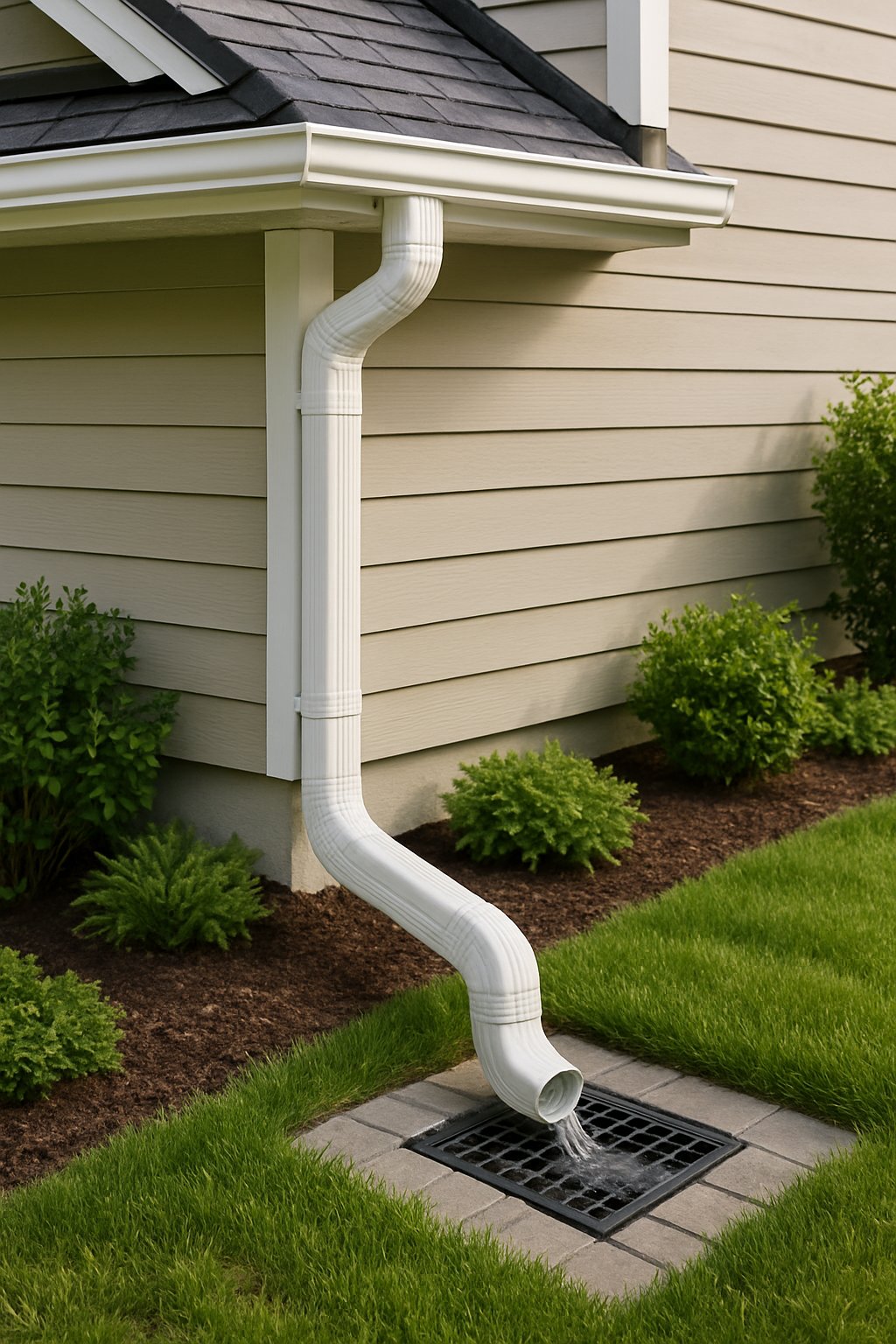
Direct your downspout runoff into storm drains to keep water away from your foundation. Just be sure the connection doesn’t block sidewalks or streets.
Underground pipes linking downspouts to storm drains keep the water moving smoothly. This cuts down on puddles and prevents soil erosion in your yard.
Expert Tip from MrPlanter: “Always inspect your connections for leaks or clogs after heavy rain. Clear debris often to keep water flowing freely.”
9. Use rain chains instead of downspouts

Swap out a boring downspout for a rain chain if you want a little style. Rain chains guide water down in a controlled way and add a decorative touch to your home.
Hang the chain straight and anchor it so it drains well. They’re best for mild climates—ice can be a problem in winter.
The sound of water trickling down a rain chain is honestly pretty relaxing.
Expert Tip from MrPlanter: “Secure the bottom of your rain chain to avoid swinging in the wind. Choose materials like copper or stainless steel for durability and low maintenance.”
- Enhance Your Home's Aesthetics: Our rain chain is a beautiful and functional alternative to traditional gutter systems....
- Built to Last: Our rain chains for gutters are made of premium quality iron that can withstand strong storms and heavy...
- Elevate Your Exterior - Replace unsightly gutter downspouts with this stunning rain chain. Enjoy the mesmerizing sights...
- Exceptional Durability - Crafted from milled aluminum and finished with a durable black powder-coating, our rain chains...
10. Create gravel-filled trenches for drainage
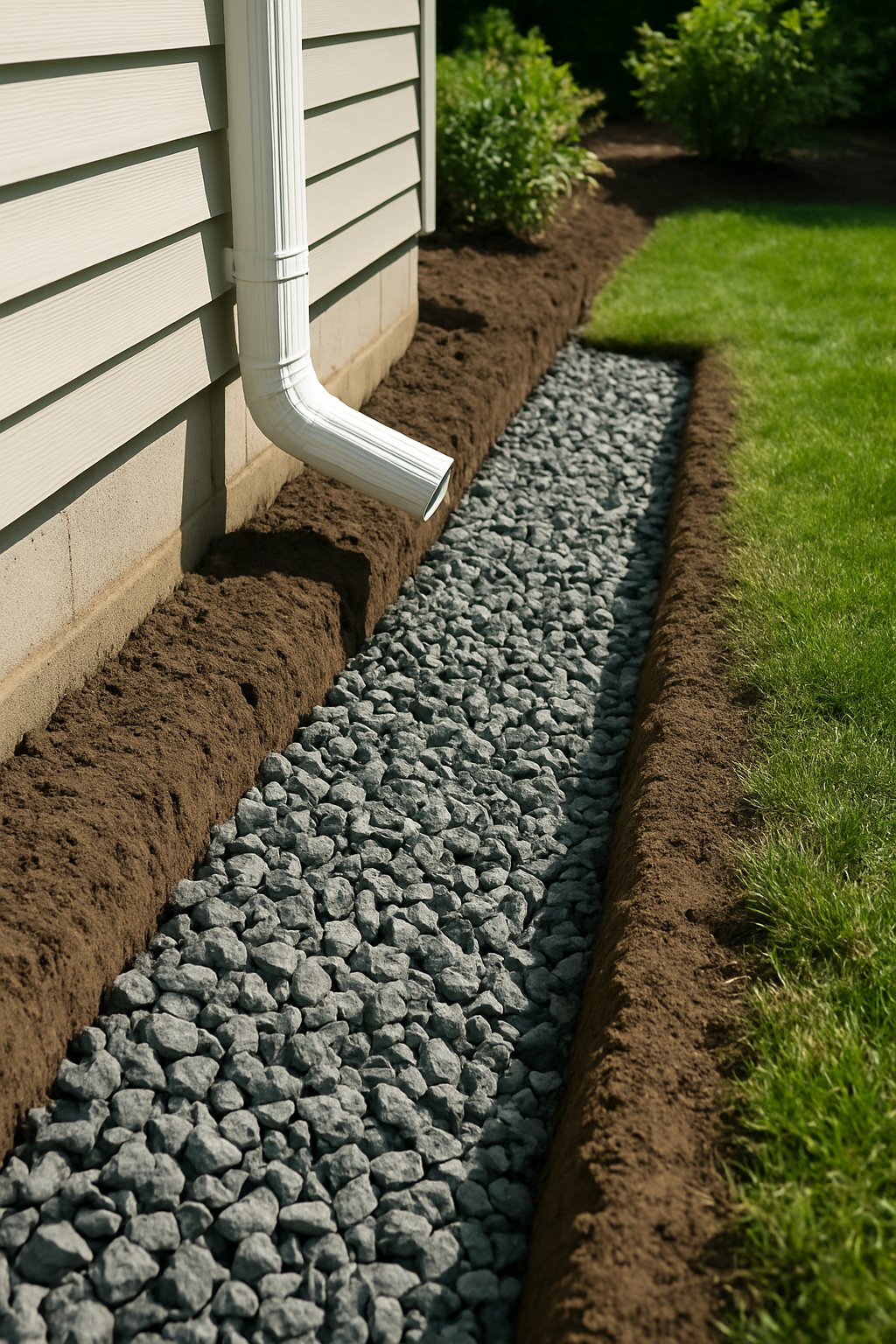
Dig shallow trenches near your gutters and fill them with gravel to help water drain away. The gravel keeps water moving and helps stop soil erosion.
Slope the trench away from your house for better flow. Cover the gravel with landscape fabric to keep dirt out.
Expert Tip from MrPlanter: “Use river-washed gravel for better water movement. Add a layer of geotextile fabric to keep soil out but let water through.”
11. Add pop-up emitters for water discharge

Pop-up emitters push water out through a small pipe once pressure builds up. They stay closed until then, which keeps water from pooling by your foundation.
Connect them to your downspouts or drainage pipes for easy water flow. They’re low maintenance and keep your yard drier.
Expert Tip from MrPlanter: “Make sure to place pop-up emitters where water can safely soak into the ground. Regularly check them for clogs to keep water flowing smoothly.”
12. Install a rain barrel to collect water

Set up a rain barrel at the bottom of your downspout to catch water from your roof. You can reuse this water for your garden and save a bit on your bill.
Keep the barrel covered to block mosquitoes and debris. Put it on a stable, raised spot for better water flow.
Expert Tip from MrPlanter: “Use a mesh screen over the barrel’s opening to keep bugs and leaves out. Connect overflow tubing to guide excess water away from your foundation.”
- 50-Gallon Capacity: Provides ample storage for harvested rainwater, ideal for watering gardens, lawns, and plants.
- Durable Construction: Made from UV-resistant polyethylene for long-lasting durability and protection from the elements....
- 50-Gallon Capacity: Provides ample storage for harvested rainwater, ideal for watering gardens, lawns, and plants.
- Durable Construction: Made from UV-resistant polyethylene to withstand outdoor elements and ensure long-lasting...
13. Use flexible downspout tubing

Flexible downspout tubing is easy to install and bends to fit your yard. It helps guide rainwater away from your foundation and stops water from pooling.
Connect the tubing directly to your downspout and stretch it as far as you need. It’s lightweight but tough enough for most rain.
Expert Tip from MrPlanter: “Choose tubing that is sturdy enough for your area’s rain amounts. Secure it well to avoid it moving during storms.”
- Maintains flow into your pond without interruption, Successfully tested by an independent laboratory for use in...
- Ponds, Aquariums, Watergardens, Rain Barrels, Fountain Pumps & Aquaculture Applications
14. Build an underground catch basin
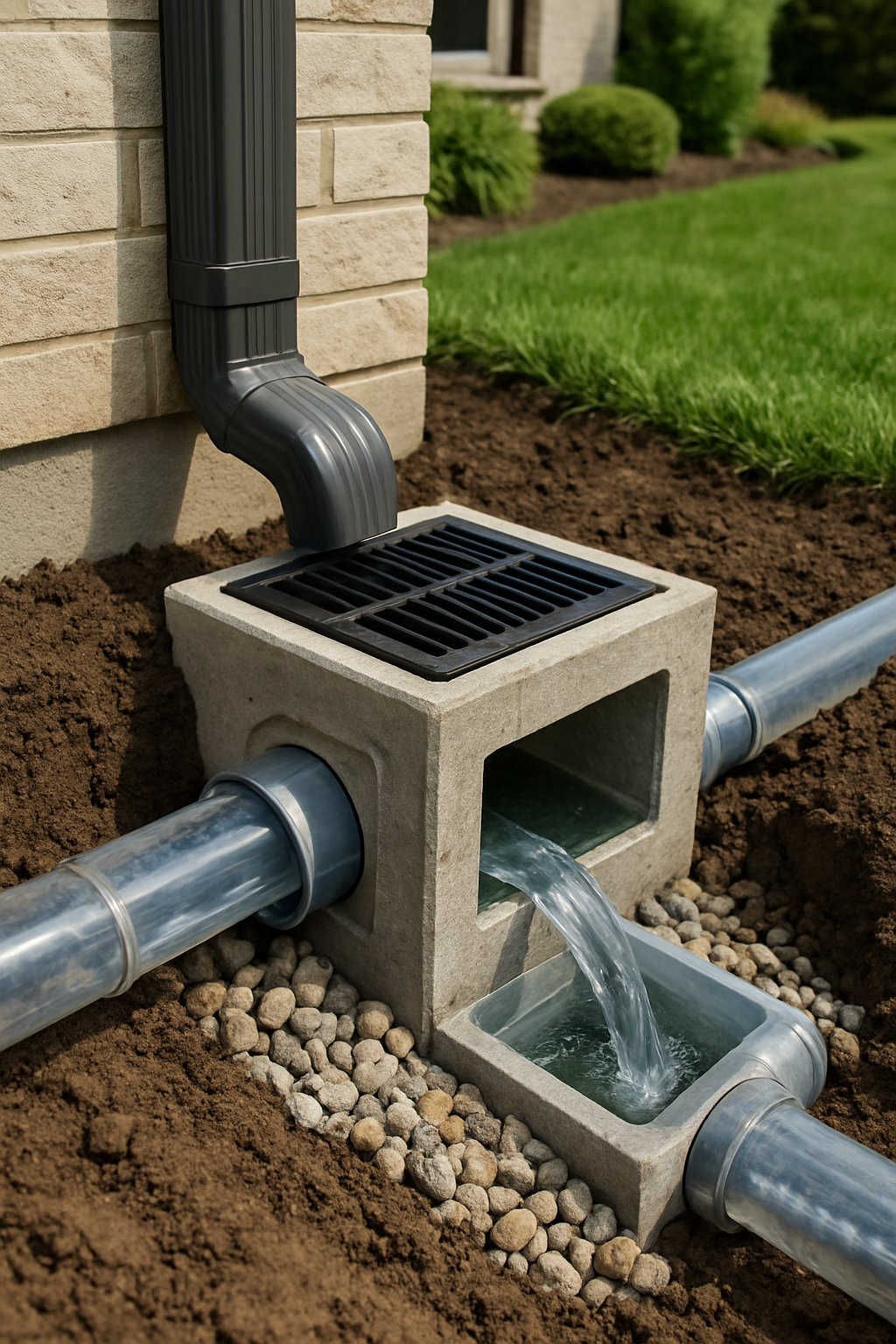
An underground catch basin collects water from your downspouts and traps debris, so your drainage pipes don’t get clogged up. Connect your downspout to the basin, then run pipes underground to move water away.
Pick a basin with a filter to catch leaves and dirt. This keeps your system working well for longer.
Expert Tip from MrPlanter: “Place the basin where water pools to stop flooding. Regularly check and clean the catch basin to avoid blockages.”
- Low Profile Design. This catch basin can be installed without deep digging. You no need to connect to the downspout....
- Pipe Size: Inside Diameter: 2 inches; Outside Diameter: 2.4 inches. Extendable Flexible Pipe from 4.6ft to 16.4ft. The...
15. Slope the landscape away from foundation
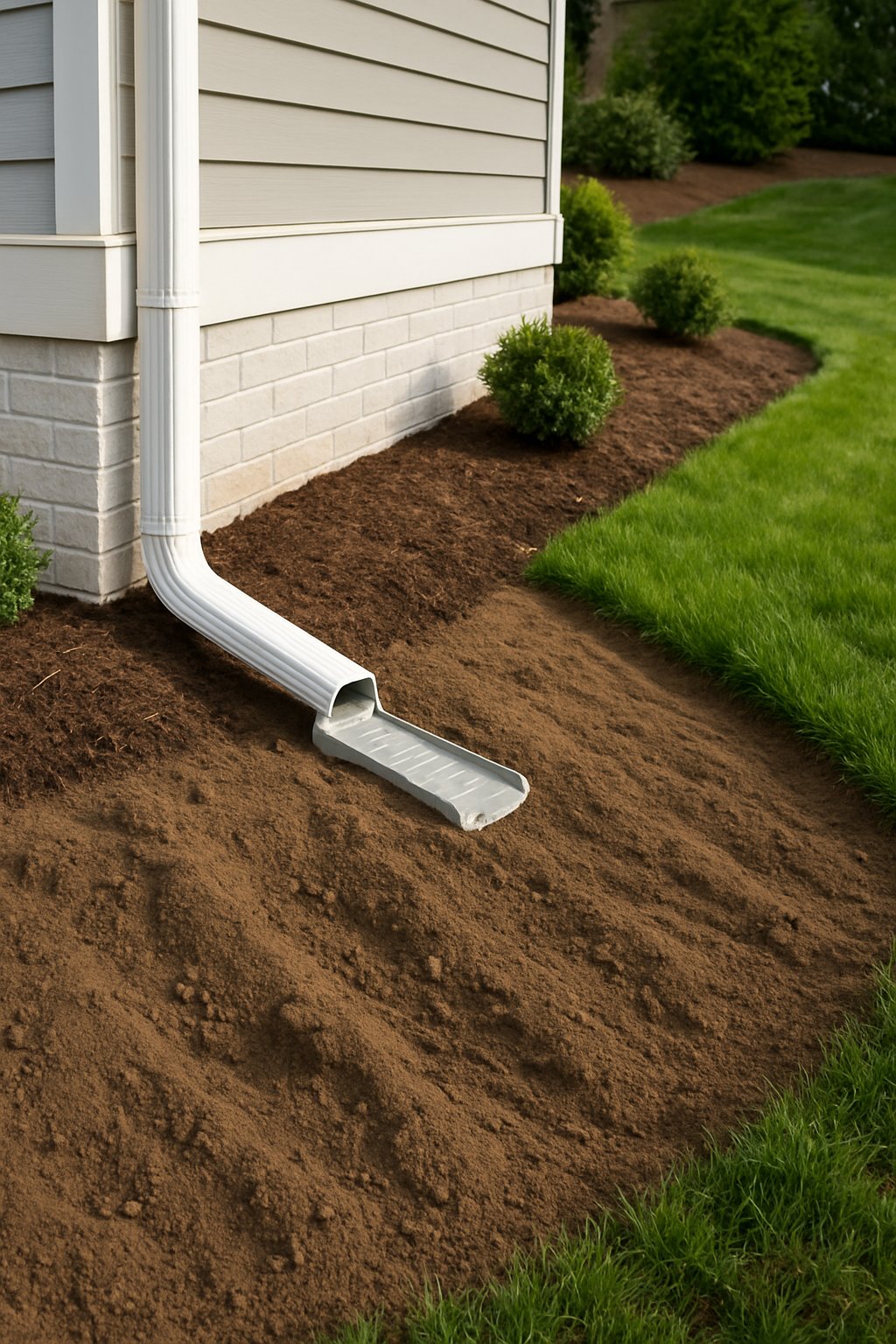
Check that the ground slopes away from your house. Even a gentle slope—about 3%—helps water run off instead of collecting by your walls.
If your yard feels a little too flat, try regrading it to create a better angle. A small hill away from your home can make a surprising difference after a heavy rain.
Expert Tip from MrPlanter: “Pour some water near the foundation and see if it moves away fast. If it lingers, add soil to those low spots so water doesn’t hang around.”
16. Seal joints with waterproof sealant
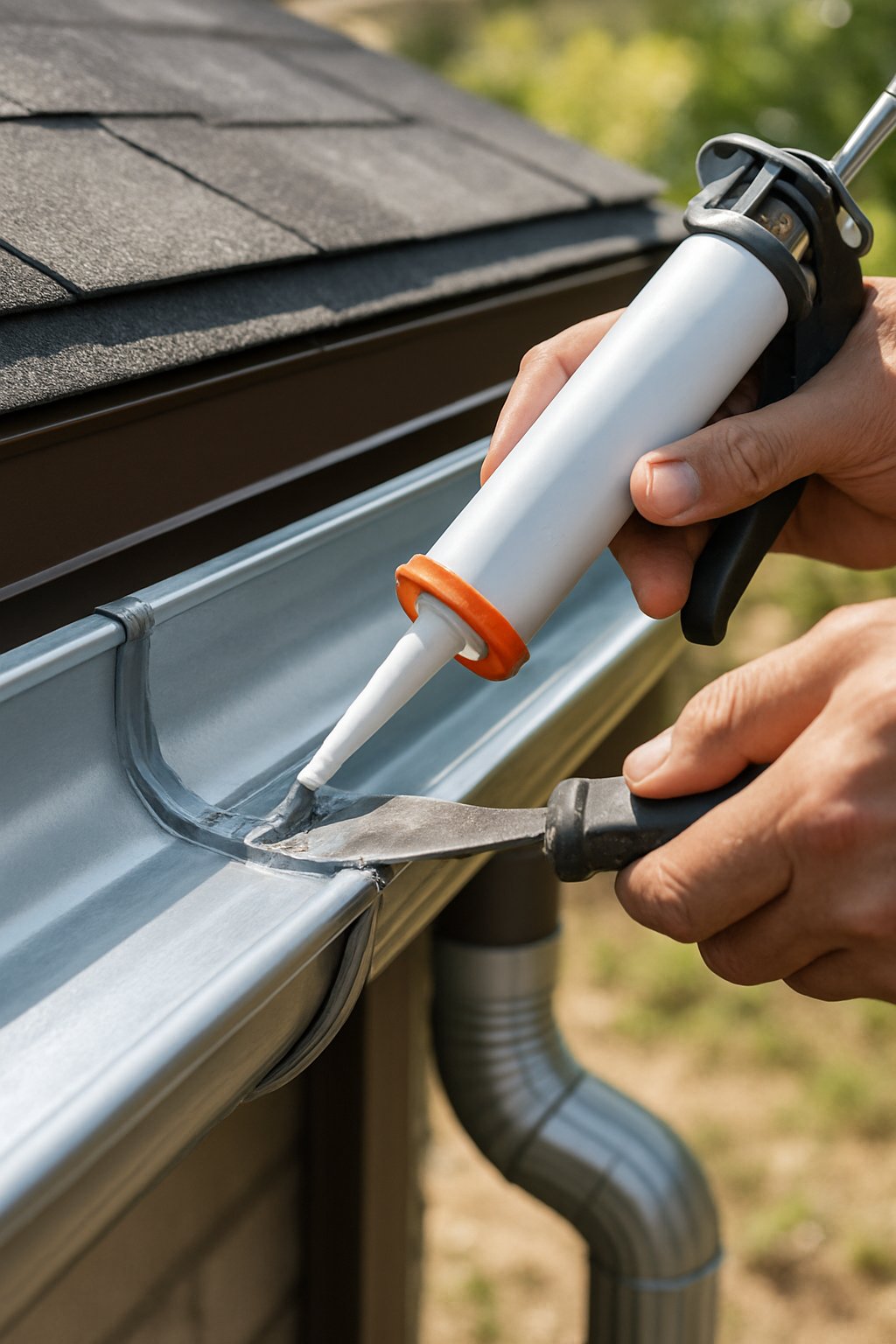
Seal your gutter joints to stop leaks. Use a waterproof sealant on seams, corners, and cracks to keep water inside the gutters and away from your house.
Clean and dry the area before you apply the sealant. This helps it stick and do its job.
Let the sealant cure fully before you test the gutters with water.
Expert Tip from MrPlanter: “Check those seals every year. If you spot cracks early, you’ll avoid bigger problems down the road.”
- MULTI-SURFACE SEALANT: A permanent solution for bonding marine substrates like wood, fiberglass, and metal
- VERSATILE APPLICATIONS: Tough yet flexible polyurethane polymer is ideal for deck housings, hull fittings, porthole...
17. Use leaf guards to prevent clogging
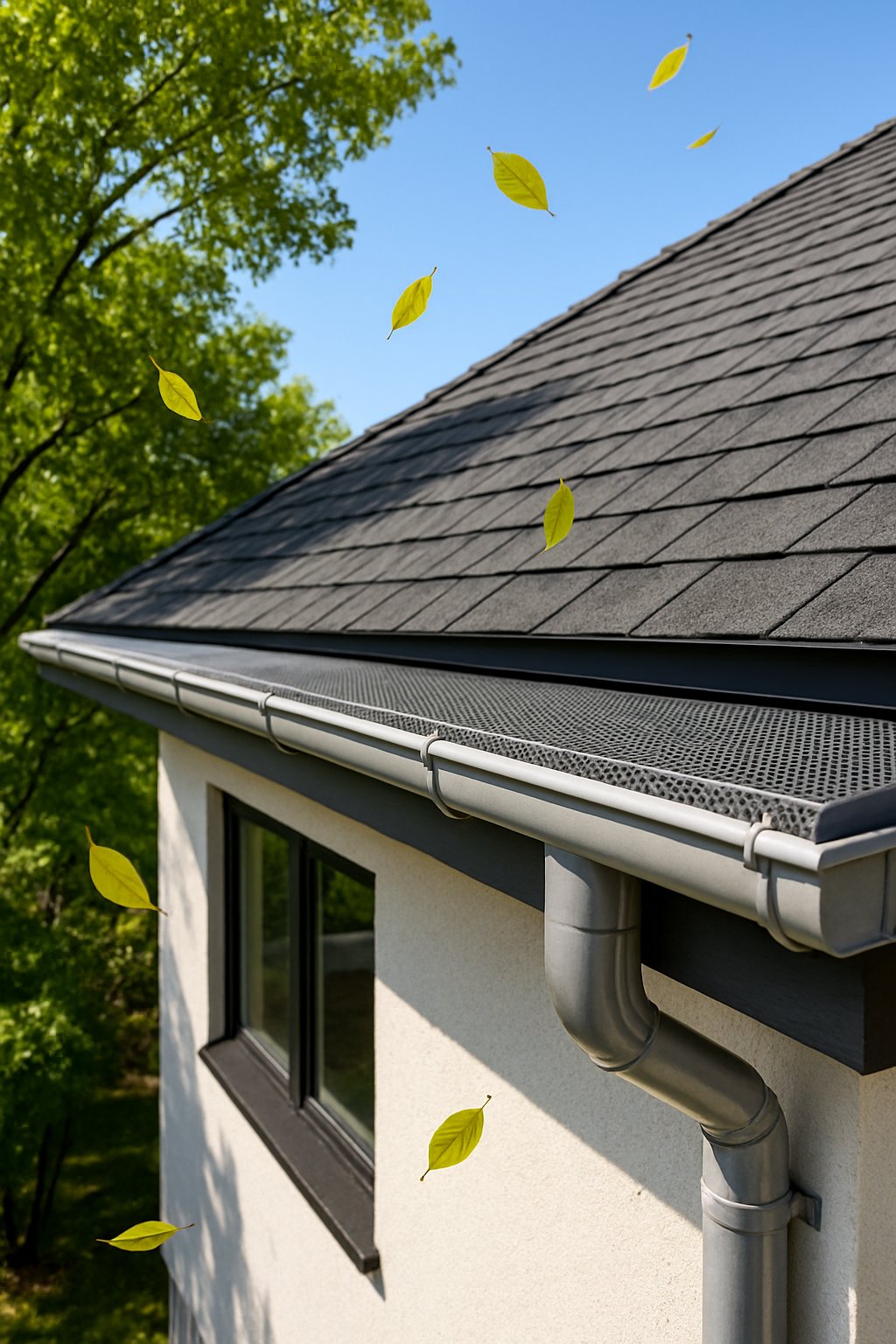
Leaf guards keep leaves and debris out of your gutters, so you spend less time clearing clogs. You’ll find mesh, solid covers, and other styles to fit your needs.
Some guards block even small leaves and moss, letting water flow through. This makes maintenance easier and lowers the risk of water overflow during storms.
Expert Tip from MrPlanter: “Match the guard to your gutter size. Give them a yearly cleaning for the best results.”
18. Hang rain diverters on roof edges
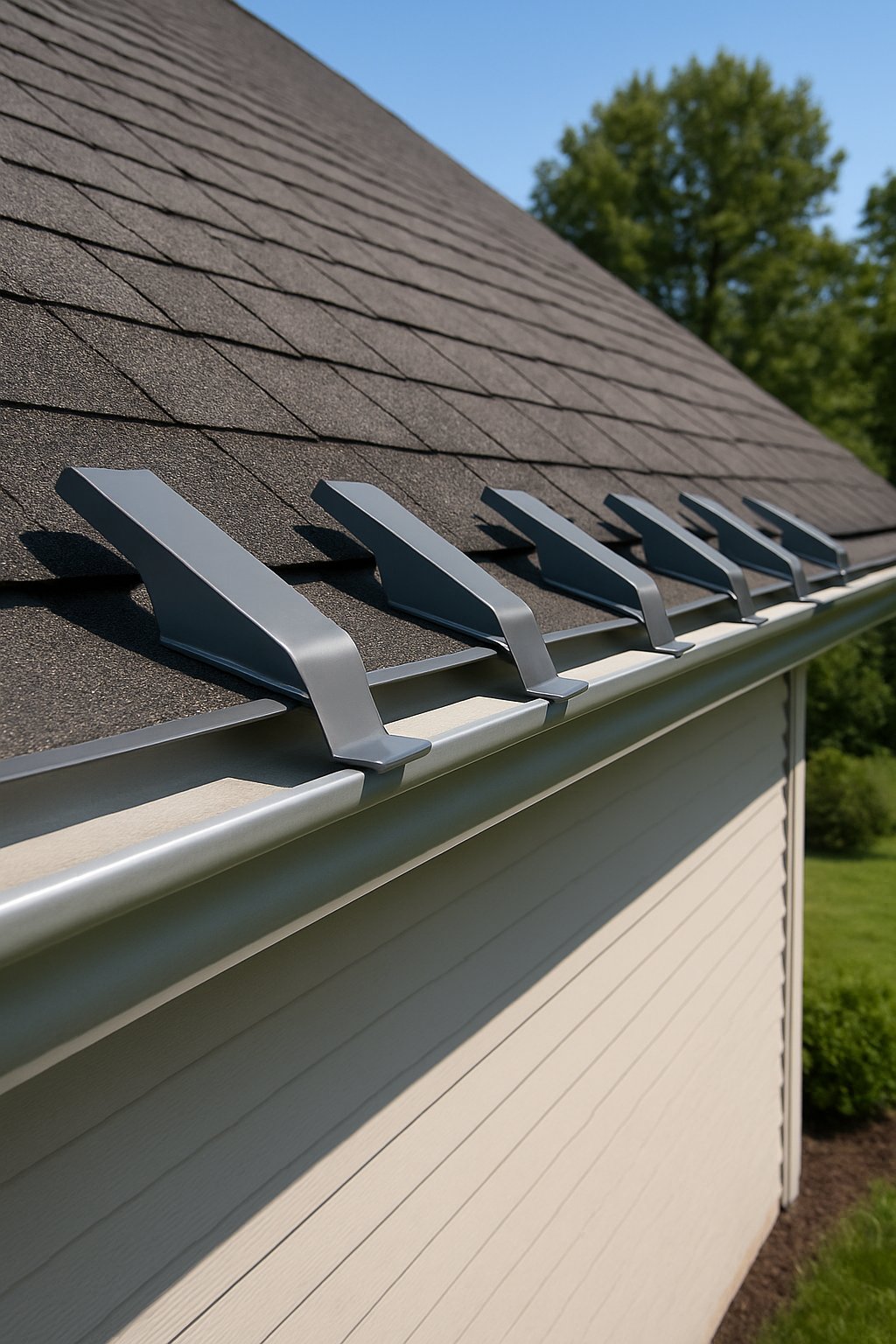
Hang rain diverters along your roof edges to steer water away from tricky spots. These little helpers keep water from overshooting gutters and causing headaches below.
Install diverters where water flows heavily—like roof valleys or corners. They’re simple to add and fit most shingle roofs.
Expert Tip from MrPlanter: “Check that diverters are secure enough for heavy rain. Give them a look now and then to keep things flowing right.”
19. Install foundation drainage channels

Install foundation drainage channels to move water away from your home’s base. These channels collect rainwater from gutters and send it off safely.
Place them around your home’s perimeter, sloping away from the house. Laying gravel or crushed stone underneath helps water drain better.
Expert Tip from MrPlanter: “Pick sturdy materials like concrete or plastic for your channels. Keep up with cleaning and check the slope to protect your foundation.”
- HDPE TRENCH BODY: 19.7x5.5x3.9 inch channel drain with grate is made of high density polyethylene (HDPE) which has...
- HEAVY DUTY HDPE GRATE: This trench grate is made of HDPE which has high strength and toughness. Loads up to 6600 lb....
- BLOCK LEAVES & DEBRIS: Protect your drainage system right from the forefront with the channel drain grate. Drains excess...
- CREATE A COMPLETE DRAINAGE SYSTEM IN YOUR YARD: Spee-D Channel Drain Grate in plastic works with the Spee-D Channel...
20. Set up a dual pipe runoff system

Install a dual pipe runoff system to handle water from your roof and yard separately. One pipe takes rainwater from the gutters, while the other deals with ground drainage.
This setup prevents water overload and helps keep your yard from flooding. It also moves water away from your foundation more efficiently.
Expert Tip from MrPlanter: “Add a catch basin between the downspout and drain pipe to trap debris. That keeps your pipes clear and working longer.”
21. Place mulch around downspout exits
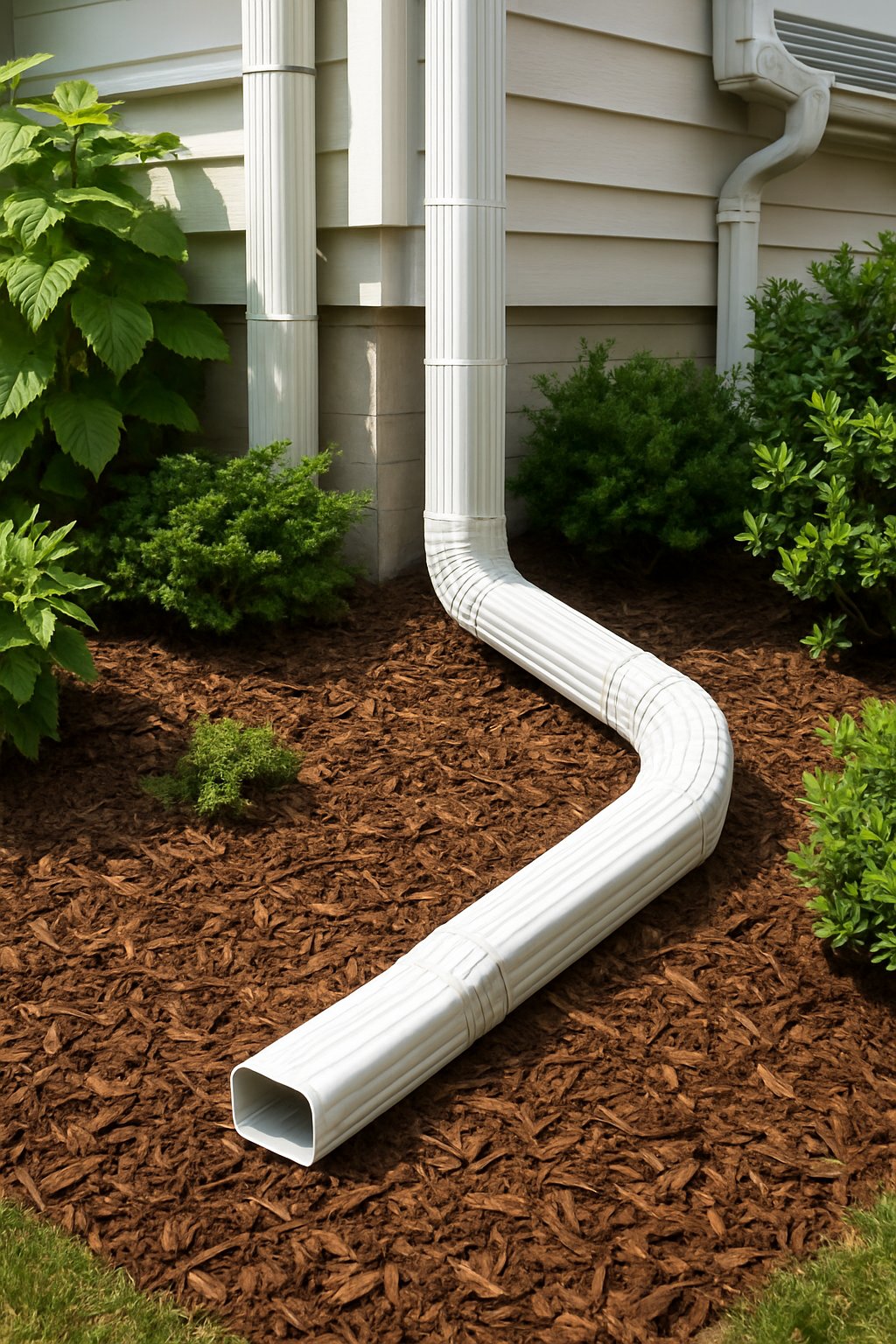
Put mulch around your downspout exits to control erosion and stop soil from washing away. Mulch soaks up some water and helps protect nearby plants from splashing.
Spread a thick enough layer to shield the soil, but don’t block water flow. Make sure the downspout sends water onto the mulch, not past it.
Expert Tip from MrPlanter: “Go with organic mulch to boost soil quality while fighting erosion. Refresh it now and then to keep it working.”
22. Use perforated pipe around garden beds
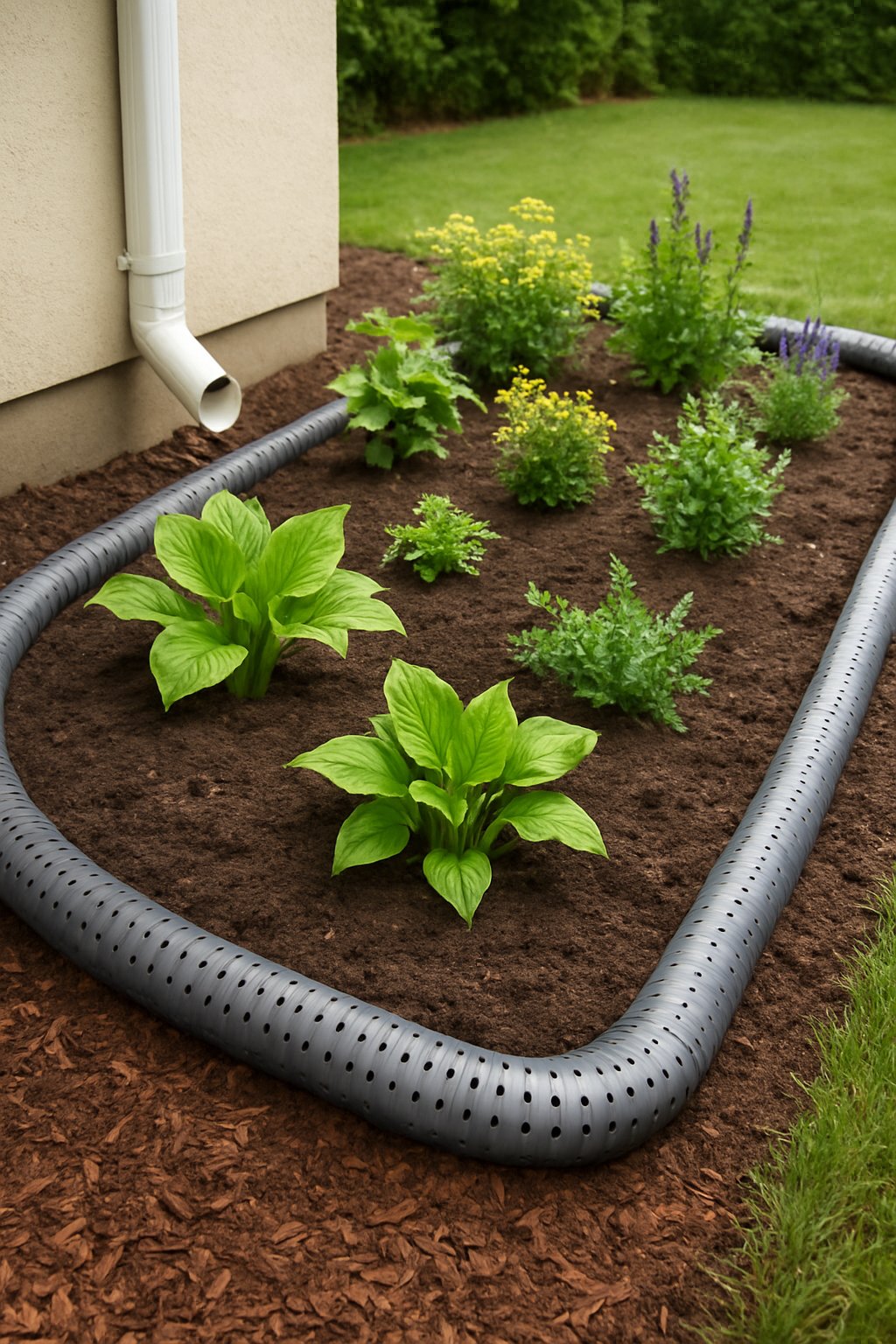
Lay perforated pipe around your garden beds to manage extra water. The holes let water drain out slowly, stopping puddles and root rot.
Surround the pipe with crushed stone so water flows freely. Wrap it with landscape fabric to keep soil from clogging things up.
Expert Tip from MrPlanter: “Slope the pipe a little so water moves away from the bed. That way, it won’t just sit and cause trouble.”
23. Install a rain garden near drainage
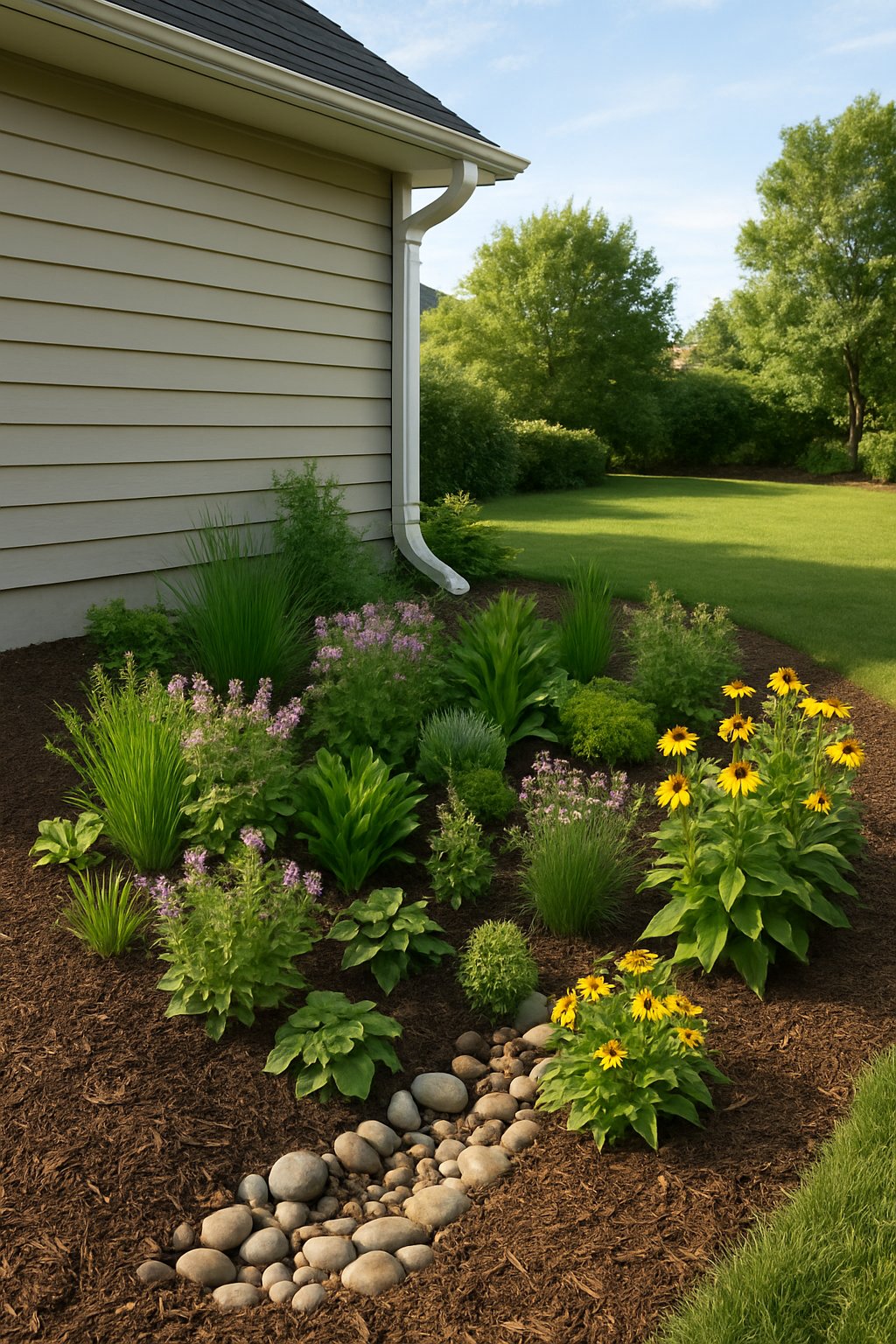
Direct water from your gutters into a rain garden—a shallow, planted spot that soaks up rain and cuts runoff.
Place the rain garden where water naturally flows, like by downspouts. This helps prevent flooding and filters the water before it hits the ground.
Use native plants that handle wet roots but can dry out too. It keeps the garden tough and low maintenance.
Expert Tip from MrPlanter: “Build your rain garden on a gentle slope for easy water flow. Pick plants that fit your local weather for the best shot at success.”
24. Use a drain grate at downspout exit

Pop a drain grate at your downspout’s exit to block leaves and debris from clogging things up. This keeps water moving and stops backups or pooling.
Choose a metal or tough plastic grate that fits over the pipe outlet. It’ll keep your drainage working even in heavy rain.
Expert Tip from MrPlanter: “Put the grate right where water leaves the pipe, so debris can’t get in. Give it a quick clean now and then to keep things flowing.”
- BLOCK LEAVES & DEBRIS: Protect your drainage system right from the forefront with the channel drain grate. Drains excess...
- CREATE A COMPLETE DRAINAGE SYSTEM IN YOUR YARD: Spee-D Channel Drain Grate in plastic works with the Spee-D Channel...
- IMPORTANT: Made for 4" Sewer, Drain, Single Wall Corrugated, and Triple Wall Pipes. Measure the inside of your pipe and...
- Debris Prevention: Ensures smooth water flow by preventing debris from entering the drainage system
25. Direct water to a swale
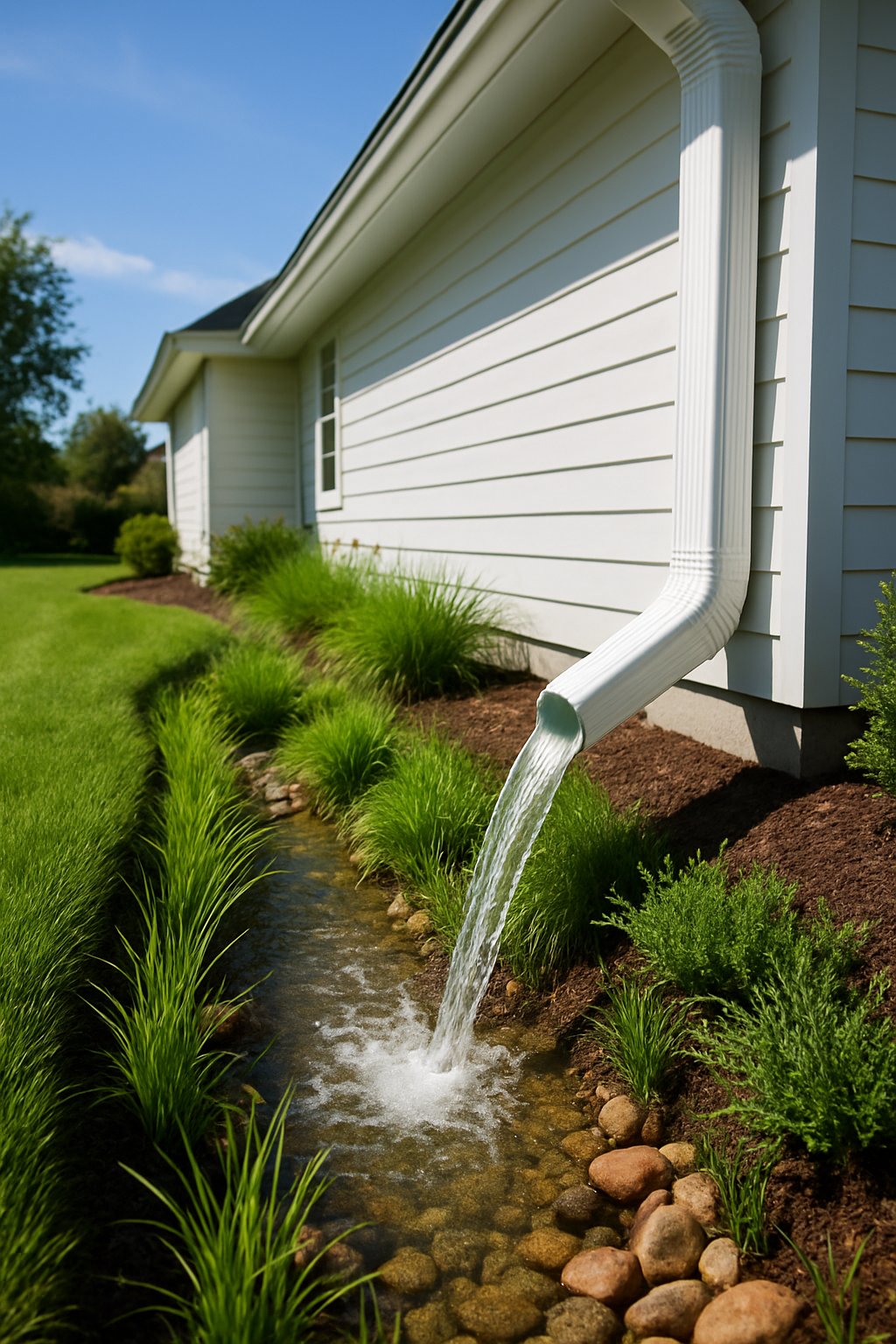
Guide rainwater from your gutters into a swale—a shallow trench that slows and redirects water. Swales help prevent flooding and cut down on erosion near your house.
They send water safely to lower ground or a drainage area. It’s a surprisingly easy, natural way to handle runoff.
Expert Tip from MrPlanter: “Keep the swale’s slope gentle so water keeps moving. Avoid sharp bends to stop pooling.”
26. Add a splash pad to prevent erosion
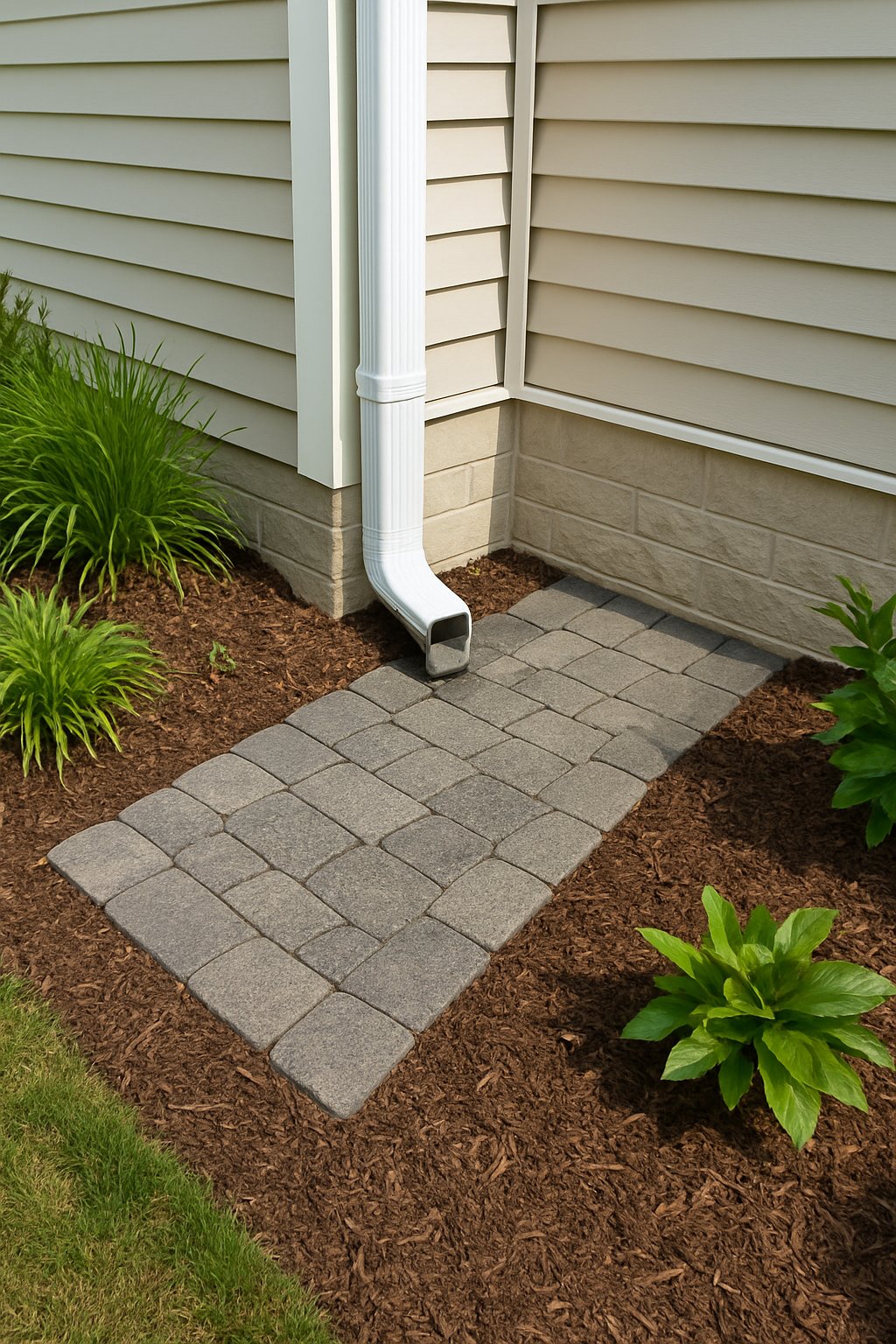
Add a splash pad under your downspout to direct water away from your foundation. It stops soil from washing out and keeps your yard looking tidy.
You can use concrete, foam, or plastic—whatever fits your style and climate. Splash pads are quick to install and help prevent mud splatters on your walls.
Expert Tip from MrPlanter: “Pick a splash pad that moves water at least a few feet from your foundation. Choose a look that matches your yard for a nice finish.”
- 【15'' Round No Splatter Pad】These round drain mats measure about 15 inches/ 38 cm in diameter and 0.79 inches/ 2 cm...
- 【Easy to Use】You only need to insert our 15" round pad in transmission drain funnels or larger oil drain pans,...
- 【2 Pieces Sufficient Quantity】The package includes 2 pieces oil drain splash pads which will meet your multiple...
- 【22'' Square No Splatter Pad】The size of no splatter pad is suitable for most transmission drain pan, the square pad...
27. Create a dry creek bed for runoff
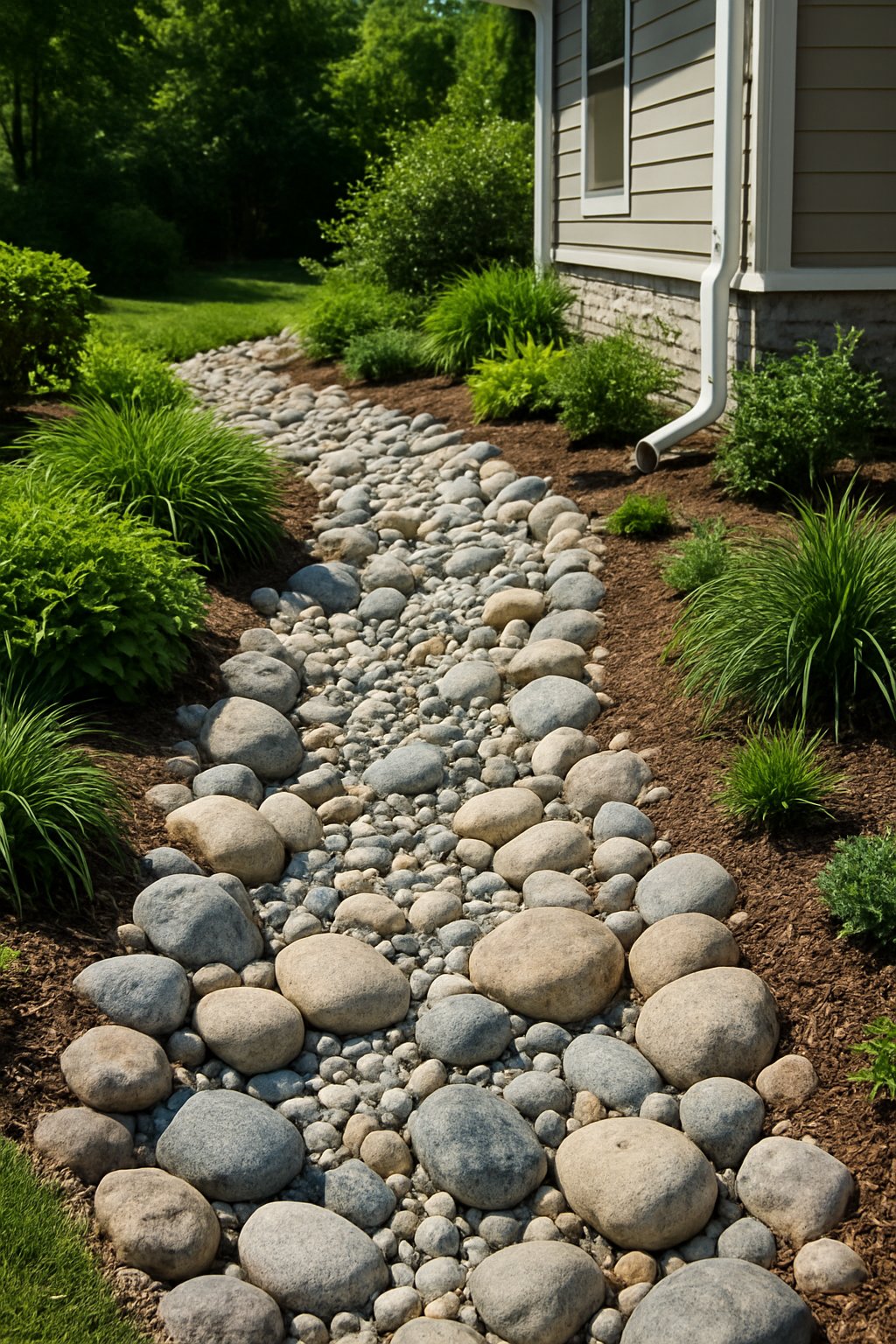
A dry creek bed offers a clever way to steer rainwater away from your gutters. Instead of letting runoff wander, you can use rocks and gravel to guide the water safely through your yard.
This approach helps you avoid puddles and messy erosion. It even adds a natural look to your landscaping—kind of a win-win.
When you set up a dry creek bed, you keep water from pooling near your house, which protects your foundation. Plus, it’s honestly pretty low maintenance and handles heavy runoff without much fuss.
Expert Tip from MrPlanter: “Choose smooth river rocks for the best flow and appearance. Make sure your dry creek bed slopes enough to move the water quickly.”



























